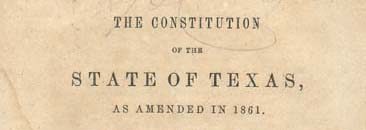The Texas Constitution establishes the fundamental laws under which all of its citizens are governed. The Constitution that we use today was first adopted in 1876. However, Texas has operated continuously under a constitutional government since 1824, a dozen years before the Fall of the Alamo!
Under the Mexican Constitution of 1824, the regions of Texas and Coahuila were combined into one state. Soon after, the state Constitution of Coahuila and Texas was adopted and governed the region.
Constitution of 1827
In 1827, the combined state of Texas and Coahuila wrote their own constitution. Its government was comprised of a unicameral legislature, executive branch, and judicial branch. The legislature contained 12 deputies, two of which were elected by popular vote. The executive branch had a governor and vice-governor and the judicial branch had courts that could oversee minor cases and crimes. There were also two provisions that many Texans ignored. One required that required Catholicism as the state religion and one that prohibited slaves.
Constitution of 1833
Wanting separation from Coahuila and their own state government, Texans met in San Felipe for the Conventions of 1832 and 1833. Several controversial Mexican policies were discussed as well. The Texans wanted to petition the anti-immigration law of April 1830, prohibit the African slave trade into Texas, pass more tariff exemptions, and have better defense against Natives. In case their requests were granted by the Mexican government, the delegates wrote their own constitution, the Constitution of 1833. It set up a state government very similar to that of the United States, with a bicameral legislature, executive branch, and judicial branch. Stephen F. Austin was sent to the Mexican capital of Mexico City to deliver the proposals but was rejected and imprisoned until 1835.
Consultation of 1835
The Consultation of 1835 met to discuss options of actions to take after the quarrels with Mexico. These included the characteristics and virtues of various leaders, the purpose of war, and the power and structure of the government. After a week of meeting, the delegates voted to support the Mexican Constitution of 1824. However, almost simultaneously, Santa Anna had begun to assume more and more power past what the Constitution allowed. Therefore, the delegates decided that Texas had the right to declare independence.
Constitution of 1836
The Convention of 1836 met at Washington on the Brazos and adopted the Texas Declaration of Independence. They also framed the Constitution of 1836, which served throughout the Republic of Texas. The Constitution set up a government much like the US’s with a system of checks and balances amongst three branches. It also allowed for slavery, gave voting rights to males, and prohibited citizenship for African Americans and Natives. Additionally, it contained a complex amendment process that was never used.
Constitution of 1845
The United States Congress proposed Resolution Annexing Texas and the Convention of 1845 was assembled to consider the proposal. The Constitution of 1845 was approved by both the people of Texas and the Congress of the United States. The bicameral legislature was continued, with Representatives serving two-year terms and Senators serving four-year terms. The governor could serve up to four years in a six-year period, or two two-year terms. They had the power to grant pardons and reprieves, was the commander-in-chief of the state militia, could convene the legislature, and veto legislation. The judicial branch consisted of a Supreme Court, district courts, and other courts. Amendments required a two-thirds vote in the legislature and a majority popular vote. It also set up a public school system and the Permanent School Fund.
Constitution of 1861
At the outbreak of the Civil War, the Secession Convention of 1861 met in Austin and modified the Constitution of 1845 to reflect Texas’ new alliance with the Confederacy. The new Constitution of 1861 was kept very similar to its predecessor as most laws were consistent with the Confederacy. The terms “the United States of America” were changed to “the Confederate States of America” and the law allowing for the emancipation of slaves was taken out.
Constitution of 1866
After the war, this was replaced by the Constitution of 1866, which served during much of the Reconstruction Era following the defeat of the Confederacy. This constitution had to include the new laws required to be admitted back into the Union, namely declaring slavery and secession illegal. Legislators were also now required to be white men and the governor’s terms were changed to four years. The Supreme Court also increased from three to five judges. Additionally, the amendment process was changed so that it required a three-fourths vote in both houses and governor approval.
Constitution of 1869
In 1869, another constitution was written after the Reconstruction Acts were passed in the US Congress. After the Constitutional Convention of 1869 dissolved over factional differences, military officers drafted the new constitution. Major changes included extending equality of the law to all persons and compulsory school attendance. Senators’ terms were also extended to six years. Texans with Confederate sympathies were barred from voting to approve this constitution, which allowed for it to be passed.
Constitution of 1876
In 1873, Democrats regained control of the Texas government and decided to rewrite the state constitution. Wanting to dramatically downsize the power and influence of the government, the writers drafted a very specific and detailed document. Legislative sessions were reduced and only allowed every other year, divided the governor’s power among several executive leaders, and divided the courts into two systems for criminal and civil cases. After being amended over 450 times, the Constitution of 1876 remains in power today.
The complete text of the current Constitution of Texas, as amended through November 5, 2019, is available below or downloadable here. This is recommended reading for all Texans!
TxConst